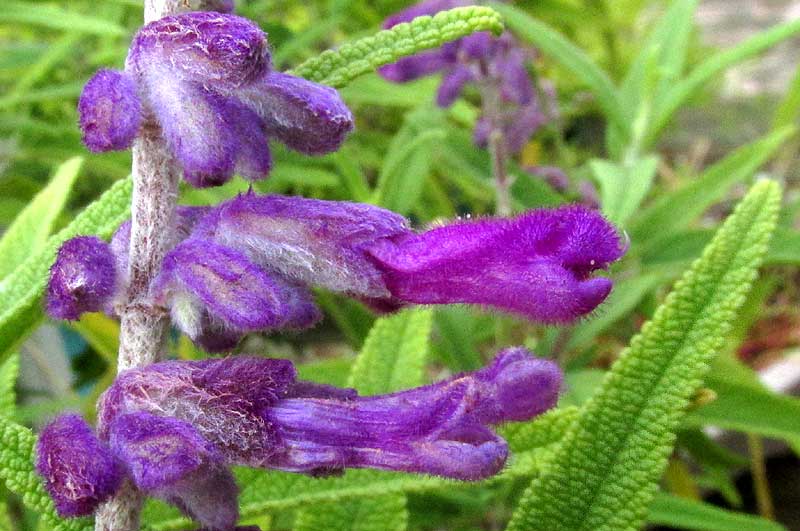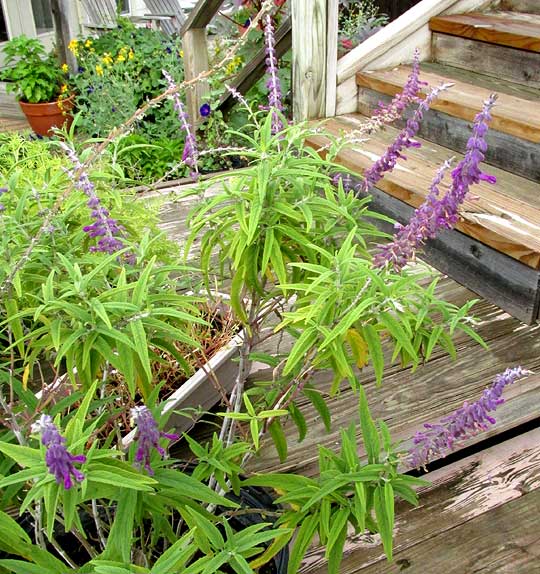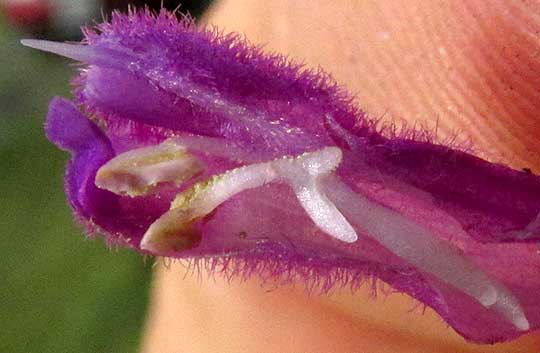Excerpts from Jim Conrad's
Naturalist Newsletter

from the September 14, 2014 Newsletter issued from the Frio Canyon Nature Education Center in the valley of the Dry Frio River in northern Uvalde County, southwestern Texas, on the southern border of the Edwards Plateau; elevation ~1750m (~5750 ft); N29.62°, W99.86°; USA
MEXICAN BUSH SAGE
My neighbor Phred keeps numerous pretty and interesting potted plants around his house. In the spring he buys them in town when small, re-pots them, keeps them watered, and now after months of growth they're spectacular. One such ornamental potted plant not seen much outside our hot zone is shown on his steps below:

Up close the purplish flowers are surprisingly hairy, the calyxes actually woolly, as shown at the top of this page.
Notice that the leaves are deeply wrinkled, or "rugose," and that they occur two per stem node (opposite). Also, the flowers arise several together at separate points along the tall, slender, spike-like raceme's central stem, or rachis. Noticing these features, the gardener might be reminded of Garden Sage, whose leaves and flowering heads are just like this. You can compare Phred's potted plant with Garden Sage on our page at http://www.backyardnature.net/n/h/gardsage.htm.
Everything looks similar except the flowers, and they're very different. Phred's plant is by no means Garden Sage. However, the above picture also shows that the flowers display bilateral symmetry -- only one way to cut them lengthwise so that both sides show mirror images of the other -- and that's also like sage.
If you've been with me through several sage species you might remember that sages, which are members of the Mint Family genus Salvia, do something tricky and distinctive with their stamens. The stamens in flowers of the vast majority of plants consist of two bag-like, pollen-producing cells side by side, like two frankfurters side by side at the end of a stick. Salvia widely separates its two anther cells, putting a long, slender "connective" between them, so that the filament is a little like a Y, each long arm of the Y bearing one anther cell. One cell on one end of the connective produces pollen normally but the other cell at the connective's opposite end is either rudimentary or completely lacking. The connective where the second cell may or may not exist then functions as a kind of lever that pollinators push against as they enter the corolla tube searching for pollen or nectar. The design is such that by pushing the lever, the anther cell full of pollen is swiveled down so that it daubs pollen on the pollinator's rear end.
So, do the flowers on Phred's potted plant display such amazing stamens? Below, aA broken-open flower shows us:

That picture, showing two stamens, is a little hard to interpret, but at least you can see that the filament is branched in a strange way, and that the anther cells appear to be single ones well separated from one another. In other words, we do have a sage, genus Salvia.
Keying out this species goes fast because very few sages produce such densely hairy flowers. Its the Mexican Bush Sage, SALVIA LEUCANTHA, a native of Mexico, but now planted widely in warmer areas. In the US it's suggested for areas as far north as USDA Hardiness Zone 8A, which includes the US Gulf Coastal Plain, California, the Pacific Coast and southern Arizona. Phred's plant look a bit spindly, but numerous plants in a garden produce spectacular masses of purple flowering spikes, which are much visited by pollinators. Different cultivars exist, with corollas ranging from white to purple.
In Mexico, wild plants of the species are used medicinally for lung ailments.